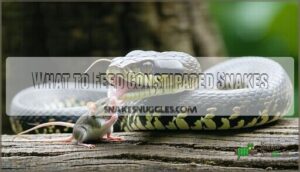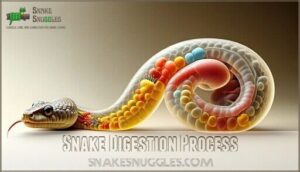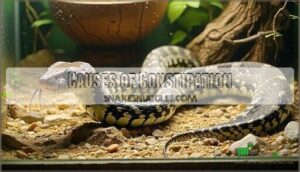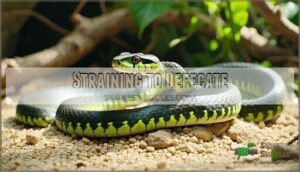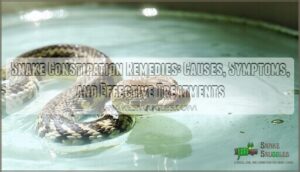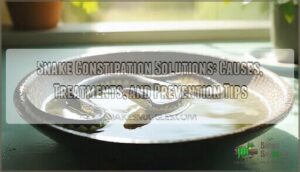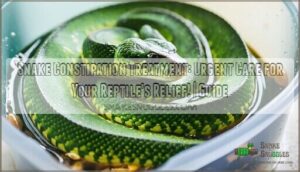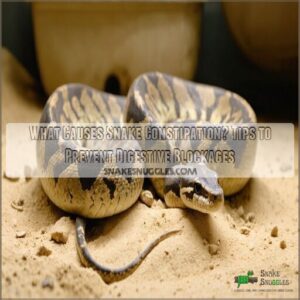This site is supported by our readers. We may earn a commission, at no cost to you, if you purchase through links.
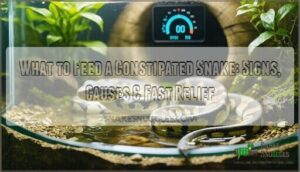
Skip the next scheduled feeding to allow their digestive system to reset. Make certain proper hydration by providing fresh water and maintaining humidity levels between 50-60%.
A warm soak for 15-20 minutes can help stimulate bowel movements. Avoid force-feeding or adding oils to prey items, as these can worsen the situation.
If your snake hasn’t defecated in two weeks, shows signs of distress, or feels unusually firm when gently palpated, immediate veterinary attention is vital.
The key lies in understanding the delicate balance between nutrition and digestive health.
Table Of Contents
- Key Takeaways
- Feeding Constipated Snakes
- What to Feed Constipated Snakes
- Snake Digestion Process
- Causes of Constipation
- Recognizing Constipation Symptoms
- Preventing Constipation in Snakes
- Dietary Recommendations
- Managing Impaction in Snakes
- Promoting Healthy Bowel Movements
- Monitoring Snake Health
- Frequently Asked Questions (FAQs)
- How to prevent constipation in snakes?
- Are snakes constipated?
- How do you get a snake to eat?
- How do you get rid of a snake poop?
- Do snakes eat feces?
- How do snakes eat their bedding?
- Can I feed my snake again if it hasn’t pooped?
- How long to soak a constipated snake?
- Can worms help a constipated snake pass stool?
- How long after medicine before snake defecates?
- Conclusion
Key Takeaways
- Stop feeding your snake until it passes a bowel movement to avoid worsening constipation or causing impaction.
- When you resume feeding, pick prey that’s 10-15% smaller than your snake’s thickest body section and choose softer options like day-old chicks or fish.
- Keep your snake well-hydrated with fresh water and maintain humidity between 50-60% to support healthy digestion.
- If your snake hasn’t pooped in two weeks or shows signs of distress, get veterinary help right away.
Feeding Constipated Snakes
When your snake is constipated, you’ll need to adjust feeding practices carefully to avoid worsening the blockage.
Feeding a constipated snake? Stop immediately until normal bowel movements return.
Stop feeding your snake until normal bowel movements resume, as adding more food can create dangerous impaction in an already compromised digestive system, which can lead to further complications, including constipation**.
Choosing Right Prey Size
When your snake’s constipated, selecting appropriate prey size becomes vital for digestive relief.
Choose prey that’s 10-15% smaller than your snake’s thickest body section to reduce digestive strain.
Following established prey size guidelines and feeding charts guarantees proper snake nutrition while preventing additional blockages.
Smaller prey items require less energy to process, allowing your snake’s digestive system to recover more efficiently.
Using proper snake feeding techniques, including prey size guidelines, is essential for maintaining a healthy digestive system, ensuring digestive relief.
Prey Type and Digestion
Beyond typical rodent prey, food quality substantially impacts snake digestive health.
High-quality prey with proper nutrient absorption supports gut health, while poor selections can slow digestion rates.
Fresh or properly thawed prey guarantees that nutrition needs are met.
Avoid prey with excessive fur content, as chitinous materials prolong digestion and may worsen constipation in already compromised snakes, particularly affecting their overall digestive health.
Feeding Frequency and Schedule
When managing constipated snakes, establishing proper feeding schedules becomes essential for digestive health.
You’ll need to adjust meal frequency based on your snake’s condition and species requirements.
Key feeding schedule considerations:
- Reduce feeding frequency – Feed every 2-3 weeks instead of weekly during constipation episodes
- Monitor digestion time – Wait 10-14 days between meals to confirm complete processing
- Establish consistent feeding routines – Same day, time, and location reduces stress
- Track bowel movements – Document defecation patterns to identify normal cycles
- Adjust based on temperature – Cooler months require longer intervals between feedings
What to Feed Constipated Snakes
When your snake’s digestive system hits a roadblock, prey selection becomes your first line of defense for constipation remedies. You’ll want to offer smaller, softer prey items that won’t tax an already compromised digestive system.
Choose prey that’s 10-15% smaller than usual to ease the digestive burden. Frozen-thawed prey works well since it’s softer than live prey, but make certain it’s properly thawed and warmed to body temperature.
Focus on snake nutrition needs by selecting prey with higher moisture content – fish or amphibians can provide additional hydration. Avoid feeding prey with excessive fur or feathers, as these materials can worsen impaction.
Your constipated snake care should include feeding tips like offering prey every 10-14 days rather than weekly, giving the digestive system time to recover. Remember, snake feeding tips for digestive health emphasize quality over quantity – one appropriately sized meal beats multiple smaller ones that could overwhelm your snake’s system and delay snake constipation relief.
Understanding snake constipation remedies is vital for providing the right care and nutrition to help your snake recover from constipation.
Snake Digestion Process
Understanding your snake’s digestion process helps you identify when constipation becomes a concern and what feeding adjustments you’ll need to make.
Normal digestion timing varies substantially between species, with rat snakes processing meals in just 2 days while heavy-bodied pythons and boas may take weeks to months.
Time to Digest Prey
Understanding proper digestion time helps you recognize when your snake’s digestive system isn’t functioning normally.
Prey digestion typically follows predictable patterns that vary based on specific factors.
Here’s what affects your snake’s digestion time:
- Prey size – Small mice digest in 2-3 days, while larger prey requires 4-7 days
- Snake species – Rat snakes defecate within 2 days, while pythons may take weeks
- Temperature – Ideal warmth speeds nutrient absorption and snake digestion process
Most snakes complete their digestion time within 3-5 days under ideal conditions, though this varies considerably by species and meal size.
Snakes often exhibit changes in behavior during the digestion process that can indicate their digestive health.
Factors Affecting Digestion
Several factors influence how efficiently your snake processes food, directly impacting digestion rates and gut health.
Food quality, prey size, and your snake’s metabolic rates all play vital roles in preventing constipation in snakes.
Humidity levels and temperature affect digestive enzyme activity, while stress can slow gastric motility.
Following proper reptile nutrition advice and maintaining consistent snake feeding schedules optimizes digestion and reduces snake constipation symptoms.
Role of Temperature and Humidity
Temperature regulation and humidity control directly impact your snake’s digestive efficiency and constipation risk.
Proper environmental balance guarantees maximal metabolic function and prevents reptile digestive issues that lead to impaction.
- Heat Sources: Maintain basking spots at 88-92°F to stimulate enzyme activity and proper digestion
- Temperature Control: Keep nighttime temperatures above 75°F to prevent metabolic slowdown and fecal hardening
- Humidity Levels: Sustain 50-60% humidity to prevent dehydration and maintain soft stool consistency
- Moisture Management: Provide water bowls and humid hides to support hydration and natural defecation patterns
Causes of Constipation
Understanding what causes constipation in your snake is essential for preventing this serious condition and maintaining your pet’s health.
Several factors can lead to impacted bowel movements, ranging from environmental issues to feeding practices that disrupt normal digestion.
This understanding is crucial for preventing constipation and ensuring the overall well-being of your pet.
Dehydration and Impaction
Dehydration acts as constipation’s silent accomplice in reptiles.
When your snake’s water intake drops, digestive secretions thicken, creating fecal blockage. Frozen-thawed prey contains less moisture than live food, contributing to dehydration causes.
| Dehydration Factor | Impact on Digestion | Impaction Risk Level |
|---|---|---|
| Low humidity ( |
Overfeeding and Obesity
When you overfeed your snake, you’re basically setting up a digestive traffic jam.
Excessive food portions and frequent feeding schedules create snake obesity, which substantially slows gastrointestinal motility.
This weight gain reduces your snake’s ability to process meals efficiently, leading to hard, impacted feces.
Overfeeding also strains internal organs, making weight management and portion control essential for preventing constipation and maintaining healthy digestion.
Overfeeding can also lead to fatal fatty liver.
Inadequate Enclosure Conditions
Your snake’s environment directly impacts digestion and bowel movements.
Low temperature below 75°F slows metabolism, creating sluggish digestion that leads to constipation.
Inadequate humidity levels cause dehydration, hardening feces into difficult-to-pass masses.
Poor substrate choice like sand or walnut shells can cause impaction when ingested.
Insufficient enclosure size restricts natural movement, impairing intestinal motility and contributing to snake health problems.
Recognizing Constipation Symptoms
You’ll notice several key signs when your snake is constipated, including bloating around the abdomen, lethargy, and a complete absence of bowel movements for several weeks.
Additionally, your snake may strain to defecate, show decreased appetite, and display unusual behavior patterns that indicate digestive discomfort.
Lack of Appetite and Bloating
Recognizing appetite loss signals digestive discomfort, as constipated snakes often refuse food when experiencing abdominal swelling.
When your snake’s digestive system struggles, feeding strikes become their natural response to prevent further complications.
Watch for these constipation in snakes warning signs:
- Visible bloating around the midsection with firm, distended belly
- Complete food refusal despite regular feeding schedules or appetite triggers
- Restless behavior combined with obvious abdominal discomfort during handling
These constipated snake symptoms indicate your pet needs immediate attention before nutritional deficiencies develop, requiring bloating relief through proper snake diet recommendations.
Lethargy and Absence of Bowel Movements
When your snake becomes less active than usual, you’re witnessing one of the most telling constipation indicators.
Behavioral changes manifest as decreased movement, reluctance to explore, and unusual hiding patterns. Physical symptoms include visible distress and complete absence of defecation for extended periods.
| Timeframe | Normal Behavior | Constipated Snake |
|---|---|---|
| 1-2 weeks | Active exploration | Reduced movement |
| 2-3 weeks | Regular feeding response | Appetite decline |
| 3+ weeks | Occasional defecation | No bowel movements |
| 4+ weeks | Alert positioning | Persistent lethargy |
Severity assessment becomes critical when these snake constipation remedies aren’t working. Veterinary consultation is necessary when lethargy persists beyond normal post-feeding periods, especially with concurrent feeding problems.
Straining to Defecate
When your snake appears to be pushing or straining during defecation attempts, this indicates significant digestive distress requiring immediate attention.
Visible abdominal contractions without producing feces suggest fecal consistency issues or urate plugs blocking the cloaca.
Abdominal palpation may reveal hardened masses, while cloacal examination can identify obstructions, which are serious issues that warrant prompt veterinary intervention to prevent serious complications.
Preventing Constipation in Snakes
You can prevent constipation in your snake by maintaining proper husbandry conditions and making smart feeding choices.
Focus on three key areas: ensuring adequate hydration and humidity levels, providing the right temperature gradient, and avoiding prey items that can cause digestive issues.
Proper Hydration and Humidity
Without proper water availability, your snake’s digestive system struggles like a car running on empty.
Maintain humidity levels between 40-75% depending on species, providing daily water changes and weekly misting frequency.
Adequate hydration methods prevent dehydration that hardens stools, while proper humidity supports shedding assistance and reduces constipation in snakes through improved water intake.
Adequate Temperature Gradient
Most snakes require proper heat to maintain healthy digestion and prevent constipation in snakes.
Establish a basking spot temp of 88-92°F and cool zone temp of 75-80°F.
Low temperature slows metabolism, causing snake constipation.
Monitor nighttime temperature drops carefully—they shouldn’t exceed 10°F.
Position heat source placement on one side to create an effective temperature gradient.
Regular temperature monitoring guarantees your snake can thermoregulate properly, promoting normal bowel movements.
Avoiding Inappropriate Prey
Beyond maintaining proper temperatures, choosing appropriate prey items directly impacts your snake’s digestive health.
Inappropriate prey can trigger constipation by creating mechanical blockages or overwhelming your snake’s digestive system.
Here are five prey items to avoid for constipated snakes:
- Oversized prey – Prey wider than your snake’s thickest body section strains digestion
- High fur content animals – Rabbits and guinea pigs contain excessive hair that slows transit
- Seeded prey – Avoid rodents fed corn or whole seeds before freezing
- White-colored prey – Natural brown or gray prey colors encourage better feeding responses
- Live prey during illness – Stick to frozen-thawed options to reduce stress and injury risk
Proper prey size should match your snake’s widest body diameter.
Failing to do so can lead to poor prey quality.
Natural prey colors often stimulate appetite better than laboratory-bred white mice, helping maintain regular snake feeding schedules.
Dietary Recommendations
You’ll want to choose prey items that promote hydration and are easily digested, avoiding anything with excessive fur, chitin, or indigestible material.
It’s important to match prey size to your snake’s anatomy and consider supplementing with essential vitamins and minerals when needed.
Prey Items to Avoid
When feeding constipated snakes, certain prey items can worsen digestive issues.
Avoid high fur content meals, exoskeleton prey, and anything containing indigestible materials like whole seeds or corn. These items create mechanical blockages and prolong digestion, increasing constipation risk.
Some owners prefer rodents with less fur to minimize digestive issues.
| Prey Type | Problem | Risk Level |
|---|---|---|
| High fur content rodents | Slows digestion, creates blockages | High |
| Insects with hard exoskeletons | Chitinous material difficult to process | Medium |
| Prey with whole seeds/corn | Indigestible materials cause impaction | High |
| Oversized meals | Leads to overfeeding and sluggish digestion | High |
Feeding Live or Frozen-Thawed Prey
For constipated snakes, frozen-thawed prey offers significant advantages over live prey risks.
Frozen food hydration helps prevent further dehydration, while prey nutritional differences remain minimal between options.
Scent enhancement methods like warming prey to 110°F improve feeding response.
You can easily purchase a thawed rodent feeder online.
Picky eater solutions include using naturally colored rodents or scent transfer techniques to encourage acceptance of safer frozen options.
Supplementing With Vitamins and Minerals
While vitamins and minerals won’t directly cure constipation, they’re essential for maintaining healthy gut function.
Most captive snakes don’t require supplements if you’re feeding whole prey, which naturally contains necessary nutrients.
However, if you suspect mineral deficiencies affecting your snake’s digestive health, consult a veterinarian before adding calcium powder or vitamin D3 supplements to avoid disrupting their delicate gut microbiome.
Managing Impaction in Snakes
When your snake shows signs of impaction, you’ll need to act quickly but carefully to avoid making the situation worse.
This serious condition requires immediate veterinary attention, as home remedies alone rarely resolve complete blockages and can sometimes cause additional harm.
Signs of Impaction
Recognizing snake impaction requires careful observation of your reptile’s behavior and physical condition. Unlike simple constipation in snakes, impaction presents more severe symptoms that demand immediate attention.
Watch for these critical warning signs:
- Bloating Symptoms – Your snake’s abdomen appears visibly swollen or distended, often feeling firm to gentle touch
- Lethargy Signs – Complete lack of movement, remaining in one position for days without normal exploratory behavior
- Appetite Loss – Total refusal of food accompanied by defecation absence lasting several weeks
Snake impaction creates a dangerous cycle where lack of defecation leads to toxin buildup. You’ll notice straining indicators as your snake attempts unsuccessful bowel movements, often accompanied by a swollen abdomen that feels different from normal post-feeding fullness.
Veterinary Care and Treatment
When impaction symptoms appear, your herp vet becomes your snake’s lifeline.
Veterinary diagnosis through radiography confirms fecal masses, while treatment options range from fluid therapy and mineral oil to surgical intervention for severe cases.
Medication options include laxatives or enemas under professional guidance.
Post-op care requires careful monitoring, and preventative measures involve correcting husbandry issues immediately, which can help prevent future cases of impaction, making preventative measures crucial.
Home Care and Remedies
While veterinary care remains essential for severe cases, several home remedies can help address constipation in snakes.
Warm water soaks for 15-20 minutes daily increase hydration and soften impacted material. Gentle massage along the snake’s belly promotes intestinal movement.
However, avoid mineral oil or milk of magnesia without veterinary guidance, as these can cause complications.
Promoting Healthy Bowel Movements
Once you’ve addressed your snake’s constipation, you’ll want to create conditions that promote regular, healthy bowel movements going forward.
This means encouraging natural behaviors, providing adequate space for movement, and minimizing stress factors that can disrupt normal digestive function, which includes promoting regular, healthy bowel movements.
Encouraging Natural Behavior
Within your snake’s habitat, enclosure enrichment becomes the foundation for triggering instinctual behaviors that promote healthy digestion.
Create hunting simulation opportunities by hiding natural prey items around a varied environment, encouraging your snake to explore and move naturally.
These activities stimulate the digestive system while addressing snake constipation through increased physical activity and reduced stress from environmental monotony, which in turn supports overall health by encouraging natural movement.
Providing Adequate Space and Exercise
Your snake’s enclosure size directly impacts intestinal motility and overall digestive health. Cramped quarters restrict natural movement patterns that facilitate proper bowel function.
- Enclosure Size: Provide minimum floor space equal to your snake’s length for adequate movement and natural behaviors
- Climbing Opportunities: Install branches, ledges, or vertical elements to encourage physical activity and muscle engagement
- Natural Behaviors: Create a stimulating environment with hiding spots, varied textures, and exploration areas
- Enrichment Activities: Rotate decorations monthly to promote movement and prevent sedentary habits that worsen snake constipation
Proper snake care includes environmental enrichment that encourages active behavior. Different snake species require specific accommodations – arboreal species need vertical space while terrestrial snakes benefit from horizontal room to roam.
Movement helps maintain healthy digestive function and prevents snake feeding problems common in static environments. Observing feces and urates can provide insights into your snake’s digestive health.
Reducing Stress and Anxiety
Most stressed snakes struggle with irregular bowel movements, making stress reduction essential for digestive health.
Create secure hiding spots with familiar substrate and minimize handling during vulnerable periods.
Keep enclosure enrichment consistent while reducing noise levels around their habitat.
Practice gentle handling techniques only when necessary, as excessive interaction disrupts natural digestive rhythms and worsens constipation symptoms.
Monitoring Snake Health
You’ll need to monitor your snake’s health by tracking behavioral changes, stool quality, and feeding patterns to catch early signs of digestive issues.
Regular veterinary check-ups and careful adjustments to diet and enclosure conditions help guarantee your snake’s gastrointestinal system stays in prime condition—no stethoscope required, ensuring complete care for your pet.
Regular Veterinary Check-Ups
Schedule preventive vet visits every 6-12 months for routine health monitoring.
Early detection of underlying issues through professional health assessment can prevent constipation before it becomes serious.
Your veterinarian provides expert advice on proper husbandry and identifies subtle changes you might miss.
Regular veterinary consultation guarantees your snake receives thorough preventative care, establishing baseline health parameters for future reference, which ensures your snake gets the best possible preventative care.
Observing Behavior and Stool Quality
Between veterinary visits, you’ll need to watch for specific behavioral changes that signal digestive issues.
Monitor stool consistency and urates appearance during regular bowel movements. Note any shedding issues or regurgitation signs, as these often accompany constipation.
Track stool frequency patterns and feces consistency changes. Understanding the snake stool characteristics can aid in early problem detection.
Document appetite changes and unusual stool patterns through careful behavioral observations for your veterinarian, focusing on digestive issues.
Adjusting Diet and Environment as Needed
After monitoring your snake’s behavior and waste patterns, you’ll need to make targeted dietary adjustments and environmental modifications when constipation persists.
Reduce prey size by 20-30% and increase feeding frequency to ease digestive burden.
Optimize temperature gradients between 78-88°F with proper humidity levels around 50-60%.
Enhance enclosure enrichment with hiding spots and climbing branches, and improve hydration methods through larger water bowls and occasional misting for effective snake constipation management, which involves proper hydration methods.
Frequently Asked Questions (FAQs)
How to prevent constipation in snakes?
An ounce of prevention’s worth a pound of cure when managing snake health.
Maintain proper enclosure temperatures above 75°F, provide adequate humidity, offer fresh water regularly, and use safe substrates like paper towels to prevent substrate ingestion and dehydration-related constipation.
Are snakes constipated?
Snakes can develop constipation when they haven’t defecated for several weeks after eating.
This condition occurs when dehydration, low temperatures, substrate ingestion, or overfeeding create blockages that prevent normal bowel movements.
How do you get a snake to eat?
Warming prey to body temperature and enhancing scent with familiar prey items often encourages reluctant feeders. Try cutting open prey or using different sizes to stimulate appetite in picky snakes.
How do you get rid of a snake poop?
Much like Hercules faced challenging labors, you’ll want to don gloves and use tongs to remove snake feces.
Clean surfaces with a reptile-safe disinfectant, ensuring the enclosure stays sanitary for ideal gut motility and overall health.
Do snakes eat feces?
No, snakes don’t eat feces. They’re obligate carnivores that consume whole prey animals. Coprophagia (feces consumption) isn’t part of their natural feeding behavior or digestive process.
How do snakes eat their bedding?
Curiosity killed the cat, but satisfaction brought it back" – your snake’s natural hunting instincts cause bedding ingestion.
When striking prey, snakes accidentally consume substrate materials like sand, aspen shavings, or walnut shells that stick to their food, leading to dangerous impaction.
Can I feed my snake again if it hasn’t pooped?
No, you shouldn’t feed your snake again until it’s defecated from its previous meal.
Snakes need to fully digest and eliminate before eating again to prevent regurgitation, impaction, and digestive complications.
How long to soak a constipated snake?
When minutes feel like hours, proper soaking duration becomes essential for your snake’s digestive relief.
Soak your constipated snake in lukewarm water for 15-30 minutes daily until bowel movements resume, ensuring water temperature stays around 80-85°F for ideal therapeutic benefit, and this process is crucial for your snake’s digestive relief.
Can worms help a constipated snake pass stool?
Earthworms can help constipated snakes by providing natural fiber and moisture that softens impacted feces.
However, they’re not a cure-all—you’ll still need proper husbandry adjustments like increased humidity and temperature to address the issue effectively, which includes providing the right environment for the snakes.
How long after medicine before snake defecates?
Despite worrying about exact timing, medicine effects vary substantially between individual snakes.
You’ll typically see results within 24-48 hours, though some snakes may take up to 72 hours to defecate after receiving laxatives or stool softeners from your veterinarian.
Conclusion
Like a skilled gardener tending to a wilted plant, understanding what to feed a constipated snake requires patience and precision.
You’ve learned that reducing prey size by 25%, switching to softer options like day-old chicks, and maintaining proper hydration are essential first steps.
Remember to skip feedings temporarily and provide warm soaks to stimulate natural bowel movements.
Most importantly, don’t hesitate to seek veterinary care if symptoms persist beyond two weeks or worsen, as your snake’s digestive health depends on prompt, appropriate intervention.
- https://www.youtube.com/watch?v=UwFqtt3idBc
- https://community.morphmarket.com/t/snake-constipation/17952
- https://lbah.com/reptile/snake-impaction/
- https://www.vetlexicon.com/exotis/reptiles/gastrohepatology/articles/constipation/
- https://enviroliteracy.org/animals/how-can-i-tell-if-my-snake-is-constipated/

